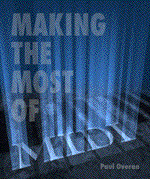 |
Bookmark Publishing is pleased to make available this part of Making the Most of Midi as a free online sample. |
Making the Most of Midi
by Paul Overaa
All rights reserved
Copyright (c) 1996 by Paul Overaa
No part of this book may be reproduced or transmitted in any form or by any means, graphic, electronic, or mechanical, including photocopying, recording, taping, or by any information storage or retrieval system, without permission in writing from the publisher.
Bookmark Publishing
The Old School, Greenfield
Bedford MK45 5DE England
Voice +44 1525 713671
Fax +44 1525 713716
ISBN 1-85550-006-X
Table of Contents
Making a Start
-
Setting the Scene
Some Midi Preliminaries
Making Your Own Midi Cables
Midi Communications
Status versus Data
Midi Channels
-
Voices, Sounds and the Midi Connection
The Multi-timbral Equivalent
Extra Notes on Synthesizer Controls
The Sequencer
Choosing Computer Hardware
Choosing The Software
Computers and Live Bands
-
When Your Midi System Starts To Grow
Merge Units
Talking Personally
Midi Switchers
Midi Patchbays
Last Words
-
Sequence Editing
Quantization
Transposition
Automated Voice Selection
Re-Channelling
-
Recording and Playback
Block Style Drum Notation
Boring or What?
Track Shifting
Randomisation
Using Midi clocks when recording
-
Guitarists
Effects Unit Control
Foot Controller Boards
Midi Filters
SMPTE/TimeCode Applications
Wireless Midi
Specialist Midi Cables
Lighting and Other Midi Control Applications
Midi to DIN Sync Conversion
Still Only Scratching the Surface
Midi Fault Finding
-
The StudioMaster MA36 Midi Analyser
Hand-held Midi Message Transmitter Units
-
The Roland GS Standard
Moving Towards A Goal
-
Midi and Sequencing
Midi Files
Percussion Units
Miscellaneous
-
Real-Time Messages
System Common Messages
Channel Messages
Voice Messages
Note-Off Messages
Program Change
Polyphonic Aftertouch (Polyphonic Key Pressure)
Channel Aftertouch (Channel Key Pressure)
Pitchbend (Pitchwheel) Messages
Midi's Controller Messages
Switch Controllers
Continuous Controllers
Mode Messages
Midi Clogging
Status Byte Structure
-
Using Sysex Control
Last Words
-
Making a Start
Enter the Midi File Proper
Overall Chunk Arrangements
Header Chunks
-
Midi Events
Sysex Events
Meta Events
Last Words
Appendix 1 Hexadecimal Numbers
Appendix 2 Notes For Hackers
Appendix 3 Even Basic Can Do
Collecting Midi Messages
And There's More...
Glossary
| Introduction | Chapter 1 | Bookmark |